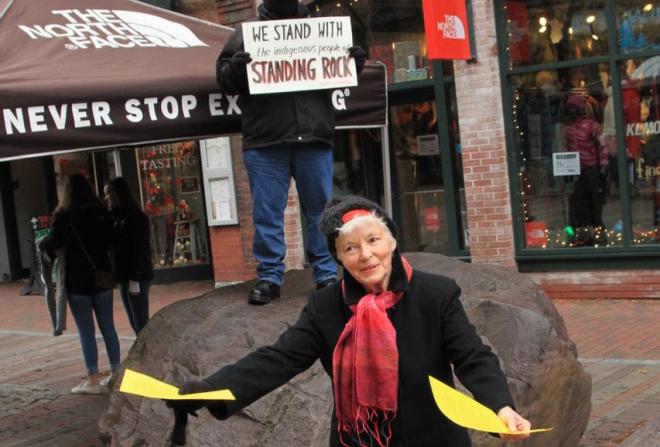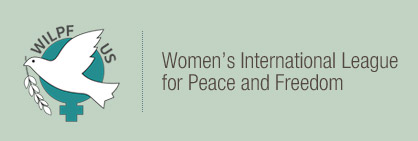Sustaining activism, post-election
Published on January, 42 2017
A group from Burlington Friends Meeting and Burlintgon WILPF stand on large rocks on the Church Street Mall in Burlington to "Stand with Standing Rock." Credit: Robin Lloyd.
By Robin Lloyd, Marybeth Gardam, and Randa Solick
Robin Lloyd of Burlington, Vermont, consoled herself after the election by attending multiple meetings to see how other women were handling the Trump triumph. She has compiled an impressive list of responses from those meetings about what is being discussed in many groups in Vermont, which mirrors conversations being held in many groups across the US. See her list, published in the quarterly newsletter of the Peace & Justice Center, Robin’s Nest: Voices of Resistance.
Marybeth Gardam reported that during the December 8 ONE WILPF Call, two breakout rooms also dealt with this feeling of dread and fear and paralysis, and with the greater call to action and coalition. Several made the point that this moment (post-election) is similar to the trauma that followed 9/11: in that moment, women in particular, who wanted and needed to talk about their distaste for revenge and their yearning for peace, were branded as unpatriotic and were targeted, sometimes even by their own families.
The little town of Burlington created a safe place for those women to meet and share their fears and their hopes, and simply to be heard. Allowing them a voice and providing a safe place to use it created activists among women who had never been active before. In listening to one another speak and being comforted and encouraged in their hopes for peace, they were empowered to ACT.
The act of creating listening posts or holding church-promoted “SolidariTEAs,” of offering safe spaces where women, immigrants, refugees, minimum wage workers, and people of color may come and speak and be heard, can be very powerful.
Randa Solick reports that in Santa Cruz, California, they are forming EMERGENCY ROSTERS to create a rapid response capability that can address immediate and unpredictable needs: people who can volunteer to care for children during court dates, who can provide transportation, legal services, and temporary housing, or who even would be able to surround homes and shield immigrants from US Immigration and Customs Enforcement (ICE), if necessary. These kinds of tactics are used by humanitarian agencies to create resilience and capacity for quick response. These are good strategies for communities, and for peace activists as well.



